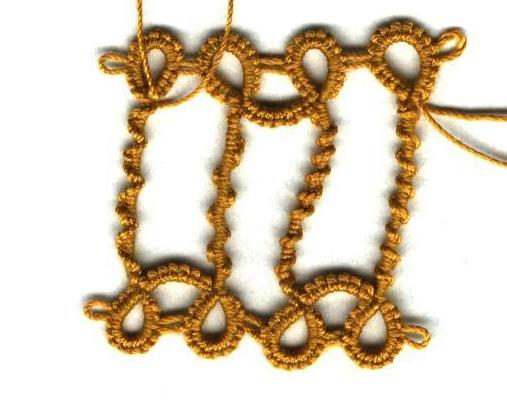

The picture above is a sampler that demonstrates so-called Victorian Sets. Victorian Sets are series of half stitches, consistently the same half. When used in chains, they are also called Josephine Chains.
From left to right, you can see:
In the picture, I've consistently used sets of five stitches. You can also use different amounts. It's up to you, experiment a little with it.
You create a ric-rac tatted chain by starting with a set of half stitches consisting of the first half of the double stitch only, followed by a set of half stitches that has only the second half of the double stitch. This is one zig-zag. Please note that this creates the zig-zag effect on the side of the work facing you.
The node stitch, so called by Elgiva Nicholls, is essentially the same stitch, but seen from the back. To create it, you first work a series of half stitches containing the second half of the double stitch, followed by a set of half stitches consisting of the first half of the double stitch. This creates a smooth chain with bumps sticking out from under it, the nodes. Note that the side of the work facing you shows this effect. The backside looks like a ric-rac tatted chain.
To create a spiral, you use sets of one half of the double stitch only, all through the chain. Following each set of half stitches, you pass your shuttle around the thread on your left hand, in the same direction as when making a knot, but without actually making a knot. This is very important! This creates the spiralling effect. When you use the first half of the double stitch throughout, you get a right-oriented spiral. When you use the second half, you het a left-handed spiral.
For stability, it's best to start and end a chain with half stitches with a double stitch. You can also add picots to Victorian Sets. Also in this case, first work a double stitch, make the picot, another double stitch, and proceed with your half stitches again.
In this example, I have used Victorian Sets in chains. With a bit more practice, you can use them in rings as well. This is slightly more difficult, but still do-able.